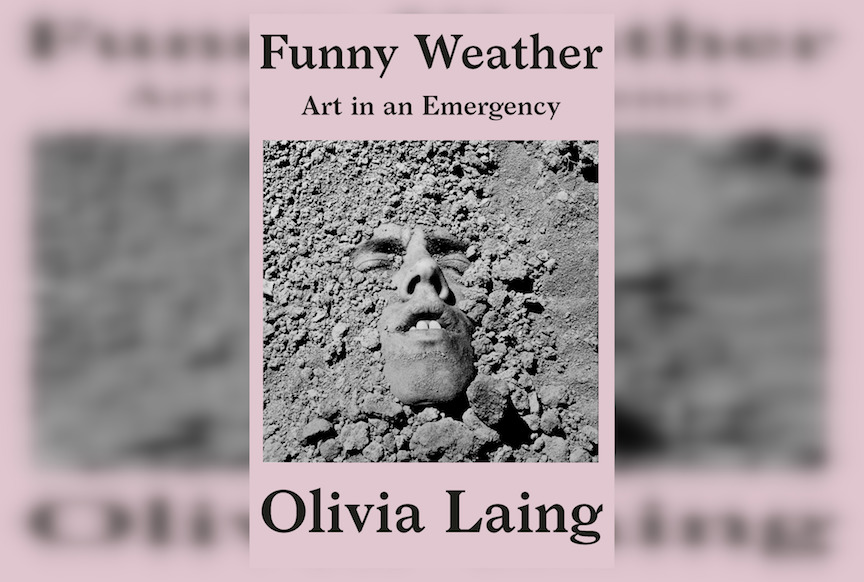It feels almost serendipitous that Olivia Laing’s essay collection Funny Weather: Art in an Emergency has been published during a global pandemic. In the wake of George Floyd’s death, another painful reminder of persisting police brutality against Black lives, an outpouring of collective rage and grief has led to protests across the country. These protests are happening against the backdrop of hundreds of thousands of coronavirus-related deaths, a failing federal government and economic collapse.
Funny Weather gathers a breadth of Laing’s past and present musings on art and its role in society. The book ranges in style and form, including artist profiles, previous works from her column in the art magazine Frieze, personal essays, cultural criticism, book reviews, and even a series of love letters to various artists. These disparate musings are brought together by her question: “Can art do anything, especially during periods of crisis?” Laing has written through Brexit, the AIDS crisis, Trump’s election, Charlottesville and racist killings by the American police. Her questions remain deeply resonant today. In this surreal time, Laing offers questions that many creative people are asking themselves: What is the role of art and artists during a pandemic? What is the role of viewers and witnesses of art?
In the introduction to her book, Laing writes of an essay written in 1967 by George Steiner about an Auschwitz commander who read Goethe and Rilke but continued his work at the concentration camp. Steiner deemed that art had failed to humanize the commander’s charges. To this, Laing writes: “But this makes art sound like a magic bullet, which should reorganize our critical and moral faculties without effort, while simultaneously obliterating free will. Empathy is not something that happens to us when we read Dickens. It’s work.” This idea of effort perhaps captures the essence of Funny Weather best.
The individual essays provide glimmers of life, suffering, pain, pleasure, and incredible willpower of past and present artists. Laing writes about Jean-Michel Basquiat and Georgia O’Keeffe—from artistic talent, unique defiance of social trends, to broad cultural significance—with refreshing sharpness. In these profiles-cum-cultural criticism essays, Laing effectively situates individual artists in larger contexts. Whether they be artistic or political, her examples document the lives of people whose efforts have impacted a larger public.
Beyond the individual chapters and sections which highlight the work of cultivating empathy through art, Laing imposes a kind of meta-effort in the structure of the book itself. The collage is loosely bound into eight sections, but the links between artists, artistic phenomenon, technique, and cultural movement are tenuous. Laing’s curatorial drive takes readers into all corners of contemporary art and literature, but the larger questions about art and politics remain unanswered. For instance, the essay “Drink, drink, drink: Women Writers and Alcohol” acts as a mini-collage of female writers who’ve suffered from alcohol addiction, but doesn’t return to the core question of art and emergency. In “The Abandoned Person’s Tale” Laing reports the story of a refugee she met through the Gatwick Detainees Welfare Group, but the man’s account of suffering is left hanging midair, without reason or sufficient reflection. It often feels like the essays are one-turn short, whether it be personal connection or cultural analysis. At times, the pieces feel scattered and without a cumulative arch towards addressing the question she sets out to answer.
Nonetheless, the breadth of Funny Weather isn’t without power. The extent of Laing’s curiosity and hunger for information is radical and exhilarating. The sheer volume and quantity of artists that are recorded and revered in Funny Weather creates its own version of hope—there are so many ways art can instill hope or collective anger or drive action in times of need.
With museums and galleries temporarily or permanently closed, Funny Weather offers a generous outlet for imagination and creativity. Even in a pre-pandemic world where one could go to the Whitney and look at a Pollock or walk through a Sarah Lucas exhibit, Laing provides windows into the personal lives of artists which add nuance and contextual meaning beyond museum labels and gallery blurbs.Laing is a knowledgeable and trustworthy tour guide in Funny Weather, introducing us to artists, artwork, and stories that we are then responsible for making meaning of in the context of our own lives. “What art does is provide material with which to think: new registers, new spaces. After that, friend, it’s up to you.” At least for me, she accomplishes that— in Funny Weather Laing passes me the baton to think about what art can do for society, and for me, today.




